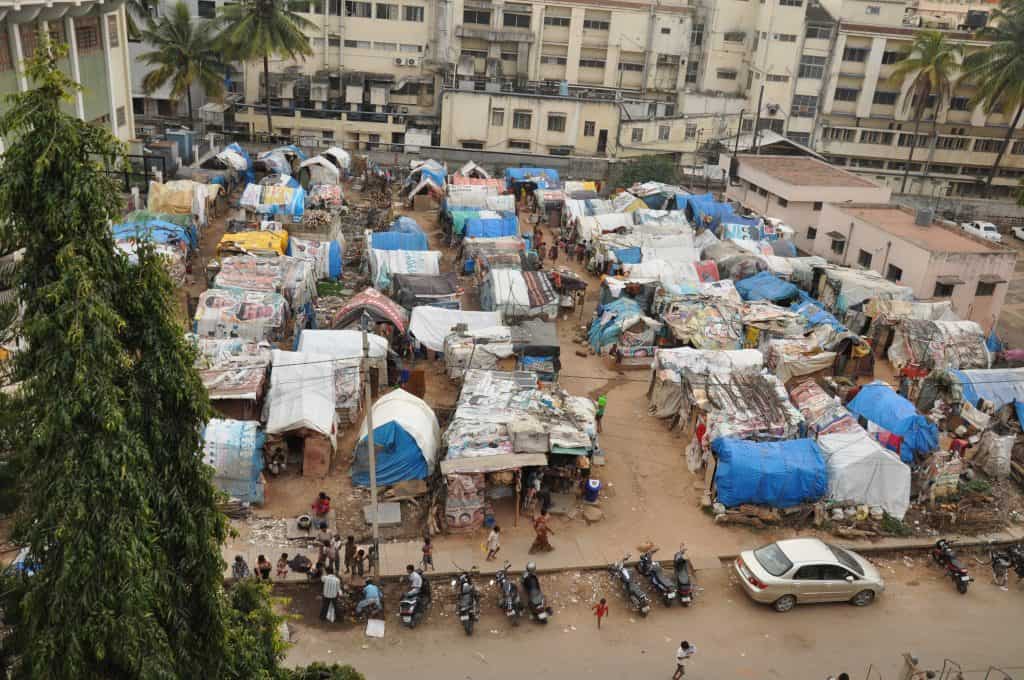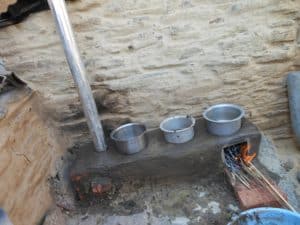This article is part of a special series: Air Quality in our Cities |
If you were to go walking in Nagavarpalya area in the city, and take the inner by-lanes ahead of Gopalan Mall, you would come upon a sprawling settlement, home primarily to migrant workers from Northern Karnataka. They stay in small makeshift structures that are covered with blue tarpaulin sheets. Such settlements are present in several parts of the city, and they are usually devoid of basic facilities of sanitation, adequate supply of water, electricity etc.
“If the migrant workers are staying with their families, they usually cook inside their houses. They use firewood to cook,” says Peer Mohammad, coordinator with the organization Sampark that works with migrant communities in Bengaluru. He mentions the build up of smoke that takes place as they cook, since the only ventilation is through the main door.
India’s record on air pollution is infamous. The recent World Air Quality Report found that 22 out of 30 most polluted cities based on PM 2.5 (particulate matter less than 2.5 micrometers) were in India, Gurugram being the worst among all cities. Bengaluru came in at 309. But while there has been considerable public discussion and awareness creation on outdoor air pollution, it is not the same with indoor air pollution (IAP).
Sources of indoor air pollution
Solid fuels used for cooking and heating constitute one of the major sources of indoor air pollution in developing countries. These fuels could be biomass (wood, dung, crop residue) or coal. Depending on the type of solid fuel used, several pollutants may be emitted, such as carbon monoxide, nitrogen dioxide and particulate matter less than 2.5 µm diameter. In Bengaluru, migrant communities in makeshift residences, such as the one described above, are the most vulnerable to this form of IAP.
However, having said that, they are not the only vulnerable group. Pollutants from outdoor sources can enter indoors anywhere and the highest exposures are found within the first 50-100 metres from roadways. ” We have to clean our house daily, otherwise the next day we end up with sneezing or some form of dust allergy. The walls too end accumulating dust and has to be cleaned at least once a week,” says a resident who lives in front of the main road near the congested Jayadeva Hospital Junction.
Another resident who stays around 20 metres from the same junction expressed similar concerns and said that “If I don’t clean the floor for even two days, I can spot a layer of dust along with black soot.” She believed this soot was a result of the emissions from vehicles. A resident who stayed along a nearby inner road said that while he experiences dust pollution, it isn’t very severe.
Indoor smoking is another source of IAP which exposes non smokers to tobacco smoke.
Besides, there are a variety of biological pollutants released from dust mites, pests, fungi, bacteria. Several household materials such as mosquito repellents, paints, lacquers etc may also release pollutants.
Effects of Indoor Air Pollution
The WHO states that in poorly ventilated houses, the smoke that is generated from cooking using solid fuels can have levels of fine particles that are 100 times higher than acceptable. The most vulnerable to pollution from cooking fuel are women and children, who spend more time inside the house. A nation wide survey found that usage of solid fuels significantly increased child mortality in the age group 1-4. Higher prevalence of asthma has been seen in the elderly who reside in houses that use bio mass fuel for cooking.
Chronic Obstructive Pulmonary Disease (COPD) in developing countries is a result of exposure to indoor and outdoor pollution, especially burning of biomass fuel. COPD is a progressive condition that inflames airways in the lungs and destroys air sacs. Claiming the lives of around a million in 2017, this disease was the second highest cause of deaths in India that year.
In addition to COPD, the WHO has listed pneumonia, stroke, lung cancer as some of the diseases that people experiencing indoor pollution are susceptible to.
Second hand smoke (SHS) from tobacco smoking consists of several chemicals, of which around 40 are identified as carcinogens. Children are most vulnerable to SHS.
Measures to address IAP
While over the years, a majority of households in the country have been covered by LPG connections, that is not the case with migrant communities in most cities including Bengaluru.
“Migrant communities find it difficult to access LPG connections even if they want to, as they lack the requisite documents. There are also behavioral patterns that prevent migrant communities from wanting to access LPG connections. They don’t find usage of LPG stoves safe,” says Shahaab Javeri ( Communication Designer -SELCO Foundation). SELCO works with these communities in Bengaluru, developing housing solutions for them with a focus on portability, proper ventilation and lighting.

A migrant community settlement. Credit- Selco Foundation website
There have been initiatives in Karnataka that provide alternatives to communities that follow traditional forms of cooking. TIDE’s mud stoves with chimney is one such alternative. Their initiatives focus on rural marginalized communities.

Cook stoves by TIDE that provide a chimney outlet for smoke. Credit- TIDE’s website
Then, there are various indoor air quality testers and air purifiers that are currently available in the market. A representative from an organization that provides indoor air quality testing shares that they provide such services for multinational corporations in different cities. “We take samples from the office, and it is tested in our labs for various parameters including nitrogen oxide, carbon monoxide, particulate matter, microbial count etc. We check for 15-17 parameters. Currently India doesn’t have indoor air quality standards, so we test it against foreign standards. We provide the corporations with the results and based on that, they can contact their vendors to improve their ventilation and filtration systems,” he said.
Equinox Labs, which also provides indoor air quality testing, said that they too work with large corporations and follow similar procedures.
Most vendors of indoor air purifiers market them on claims that they are able to filter out 99 percent of particulate matter and other pollutants. But how effective are they ? A research study in 2016 looked at the effectiveness of indoor air purifiers in Delhi. During the months of December and January (when pollution levels are very high) the researchers measured outdoor air quality against indoor air quality in an apartment where an air purifier was used. The study found that there was a drastic reduction in particulate matter with the usage of air purifiers but noted that it was still frequently worse than moderate and high pollution levels recorded in several other cities in the world.
In addition, the study found that there is significant co-relation between outdoor and indoor air pollution, with improvements in indoor air quality (after using purifiers) diminishing as the outdoor air quality worsens.
The authors assert that even though usage of indoor air purifiers is associated with significant reduction in particulate matter, the particles that remain may be cause for concern. The solution therefore is incomplete, and they advocate for policy actions that aim at reduction of outdoor air pollution.
| This article is part of a special series: Air Quality in our Cities, and explores the root causes for air pollution and solutions for improving air quality in Bengaluru and Chennai. The series is supported with a grant from Climate Trends. |
While appreciating the author’s concern on air pollution due to use of firewood for cooking by migrant labourers, I wish to draw the attention of Authorities for providing proper living space for these laberers by the Building developers while recruiting them. These people have to live for years to jobs till the construction of Buildings were over.They should have proper living quarters with basis aminities like Living quarters,transport,electricity, water and toilets while they perform their duties. Providing these should be the responsibility of the Contractors/developers.
I do not know whether the rules for granting permission for constructing Buildings have such conditions. If they are there, then they should be strictly enforced.